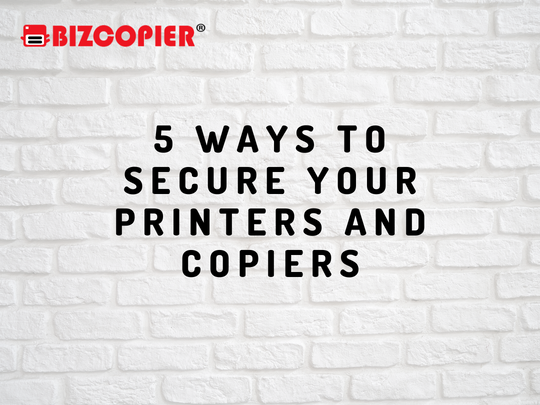5 Ways to Secure Your Printers and Copiers

Copiers and printers are vulnerable to data loss. Modern machines contain hard drives, which can result in data breaches or other types of theft. Private documents can be downloaded, and in some cases, print activity can be rerouted, allowing hackers to gain network access via printing software. All of the most dangerous types of malware, such as Trojans, DDoS attacks, spear-phishing, and ransomware, can affect the data generated by print jobs or run through your printer queue.
Here are five ways to secure your printers and copiers:
1. Disconnect Printers and Copiers
When you disconnect these machines from the Internet, the possibility of hacking activity decreases dramatically. Hackers can only physically gain access to disconnected printers and copy machines. However, this also reduces operational efficiency. Consider whether an offline strategy is beneficial to your company.
2. User Access Controls
Specific user access controls are another way to protect printers and copiers. Creating user accounts with varying levels of access limits access and prevents unauthorised parties from using printers and copy machines for malicious attacks. Examine the Identity and Access Management (IAM) field to see what vendors can offer assistance.
3. Firmware and Settings
Printers can often protect themselves from various types of hacking by utilising the firmware built into their operating systems. There is also the possibility of using a network firewall to prevent malicious activity related to accessing the data that printers share with other network elements. Consider this a “perimeter approach,” in which you create a stronger barrier against incoming hacking activity. To keep your printer and copier data safe, cybersecurity firms can also assist with firewall calibration and cloud security.
4. Network Segmentation
When it comes to protecting sensitive data, this overall security principle is extremely valuable.
Network segmentation entails isolating various parts of the network and separating them from one another. This boosts security capacity. For example, if printing equipment is on a different network segment than another that handles much of the public traffic, hackers will find it more difficult to infiltrate that printer network.
Network segmentation has become a best practise in enterprise because it effectively thwarts hacking efforts. Examine your overall SOA to see if segmentation or isolation can help.
5. Overarching Cloud Service Models
Third-party vendor products are increasingly being used by businesses to direct their networks. Smart enterprise network configurations will automate printer and copy machine security in the same way that they will automate other types of network security. Investigate what vendors can provide to keep a network safe and secure. A cloud solution configuration can provide encryption at the point of egress as well as a secure tunnel on either side of the client/vendor pathway.
Consider whether any of these methods can keep your printing data safe. Investing in printer and copier security allows your company to mitigate risk, protect systems, and guard against data breaches and other disasters while still allowing you to complete print projects.

*Other Model Available
RICOH MPC3503/ MPC5503 | RICOH MPC3504/ MPC5504
CONTACT US: 03-3341 6296 | 018-788 6296 | 018-228 6296





Recent Comments